My handy master scones recipe is just what you need to bake up perfectly tender scones every time without fail. The base recipe includes 7 core ingredients, plus optional egg, with all of my favorite stir-ins and additions so you can customize your scone flavors. Read on to master scone baking and create your own signature scones!
Try my blueberry cream cheese scones, strawberries and cream scones, or savory jalapeno cheddar scones.

Jump to:
- 🥘 Ingredients
- 👩🏻🍳 How To Bake Perfect Scones
- Bake, Cool & Serve
- 🚫 How To Make Gluten-Free Scones
- 💭 Angela's Pro Tips & Recipe Notes
- 🔐 Secrets For Tall, Flaky Scone Perfection
- 🥣 Add-ins & Scone Flavors
- 💧 Making Adjustments For Moisture
- 🧁 Optional Scone Toppings
- 🥄 Make Ahead Options
- 🥡 Storing
- 📖 Recipe Card
- 💬 Comments & Reviews
Baking up a great batch of scones is an easy weekend breakfast or brunch, the perfect treat to enjoy with coffee or tea, or an amazing snack to bring in to work.
This recipe has been tested and perfected through years, or um, decades of baking delicious scones. Follow my easy step-by-step instructions to master scones that are better than bakery scones, no matter your experience level.
🥘 Ingredients
One of my favorite things about making scones is that my base recipe uses simple pantry staples - and just 7 core ingredients. If you're missing one, there's a swap that's almost perfect (and it's still one of your pantry staple ingredients).
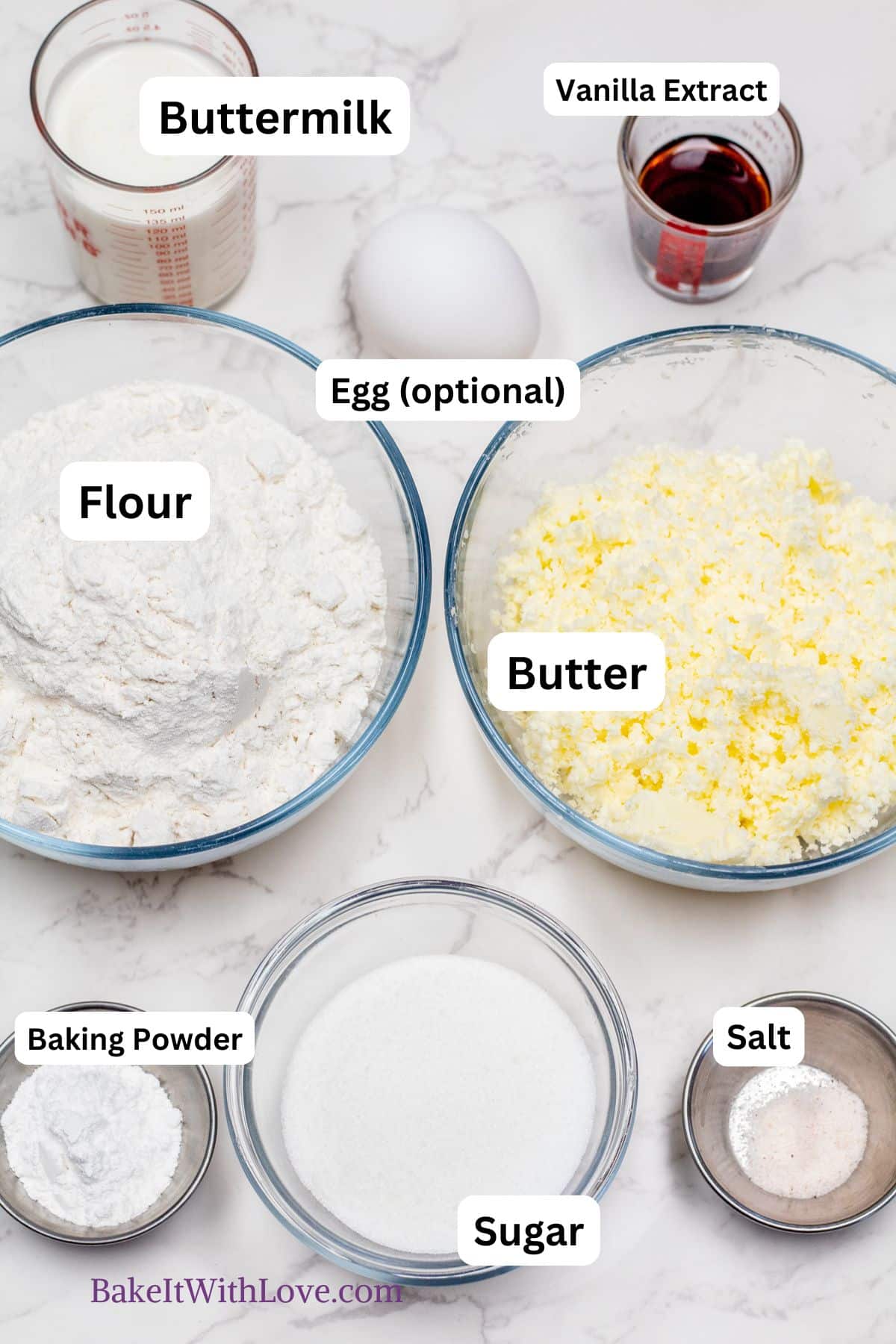
- Flour - This is the base or bulk item of your scones. You may need more for adjusting the dough consistency, as well as flouring your pastry mat or working surface, or for coating stir-ins (especially wet fruit, see my making adjustments for moisture section below).
- Sugar (reduce for savory scones) - Just the right amount of sugar to make the tender crumb of a scone. Use brown sugar, honey, or maple syrup if desired. Powdered sugar may be used for dusting scones or making icing. Across the pond they would note that English scones should not be overly sweet, even though we tend to like American scones that way.
- Butter - The second main ingredient of your scones, and a vitally important one for the perfect scone texture. You need cold butter (salted or unsalted butter) to create the rise, flakiness, tenderness, flavor, and the delightfully crispy edges on your baked scones.
- Buttermilk or Cream - Opt for one of these creamy dairy products, or half & half. If you can find full-fat buttermilk, you're in luck (but lowfat buttermilk is typically what's available in stores). Do not use thin dairy products, skim milk, 2%, and whole milk do not have enough fat content to create the rich, flaky texture of traditional scones. Milk substitutes like almond milk and coconut milk will not have enough fat content either.
- Vanilla Extract (omit for savory scones) - Vanilla, like salt, highlights the flavors of your other ingredients and contributes to the sweet flavor of scones.
- Baking Powder - The leavening agent that adds lift to the scone texture and helps make them airy and light.
- Salt - Highlights all of your scone flavors and makes sure that the end result is not overly sweet.
- Egg (optional) - You can use your whole egg in the scone dough, or just the yolk (reserving the egg white for an egg wash to brush over the scones before baking), or omit the egg entirely. An egg makes 'enriched' scones - adding richness, flavor, and great texture to your resulting scones.
Can I Use Bread Flour? Cake Flour? Pastry Flour?
Yes, yes, and yes! The high protein in bread flour works well in scones but the texture may be dense and not as tender. Alternatively, cake flour has a lower protein content yielding a tender crumb and plenty of airy height - maybe too tender.
If I have pastry flour (which has a slightly lower protein content), I find it perfect in scone baking, maybe better than all-purpose flour. However, I don't go out of my way to get it for baking scones.
Should I Use Buttermilk or Lemon Juice?
You can use either buttermilk or lemon juice (as well as cream of tartar, sour cream, or honey) as your acid to activate the leavening agent, add tender crumb, plus a great tangy flavor to offset the sweetness of added ingredients. Both work wonderfully, with heavy cream yielding a rich, dense crumb and buttermilk yielding a lighter, airy texture.
If you don't have buttermilk (or buttermilk powder you can reconstitute), see my guide for buttermilk substitutes here.
Be sure to see the free printable recipe card below for ingredients, exact amounts & instructions with tips!
👩🏻🍳 How To Bake Perfect Scones
Grab your base ingredients plus any desired stir-ins, measuring utensils, a mixing bowl, pastry mat, parchment paper, and a baking sheet to whip up some amazing scones.
This base recipe yields 8 standard-sized wedge-shaped scones cut from a 1 to 1½-inch-high, 8-inch round disc. You can also cut approximately 10-12 round scones using a biscuit cutter, portion out 10-12 drop scones, or make 16 petite scones/mini scones.
Prep The Butter & Ingredients
Step 1: Grate the butter. Your ½ cup (113.5 grams) of butter should be chilled and preferably frozen. You can grate it on a box grater, but I prefer to use a food processor (the heat from your hands can melt the butter).
Scrape the shredded butter from your food processor bowl into a clean bowl and pop the bowl of butter back into the freezer while preparing the other ingredients.
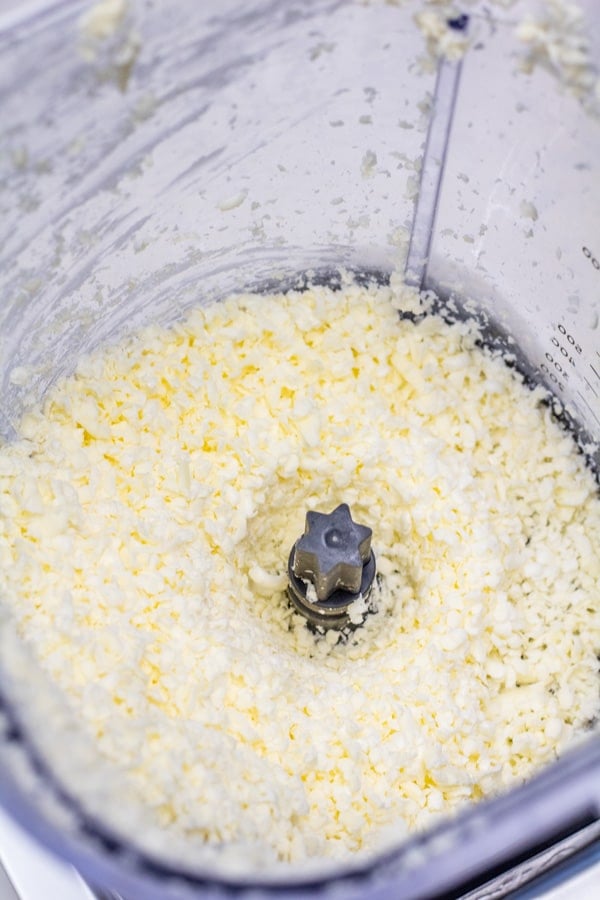
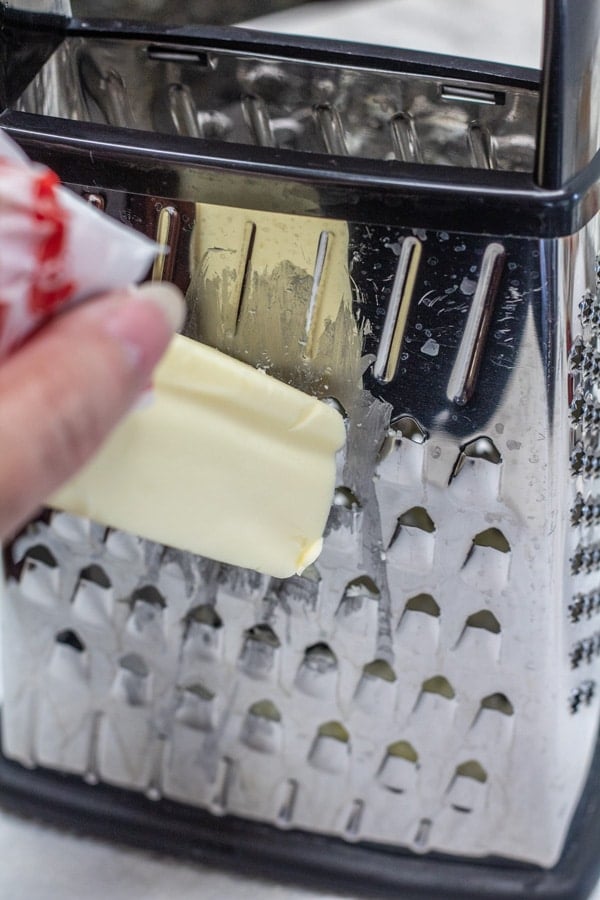
Step 2: Measure out your remaining ingredients. Return any cold ingredients to the fridge. *My flour is stored in the freezer, which is a bonus!
Mix The Scone Dough
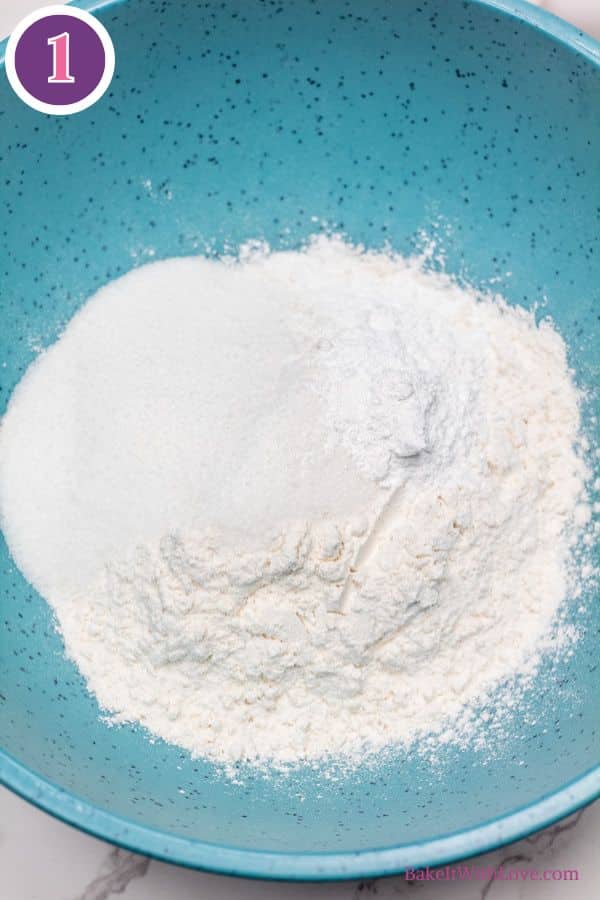
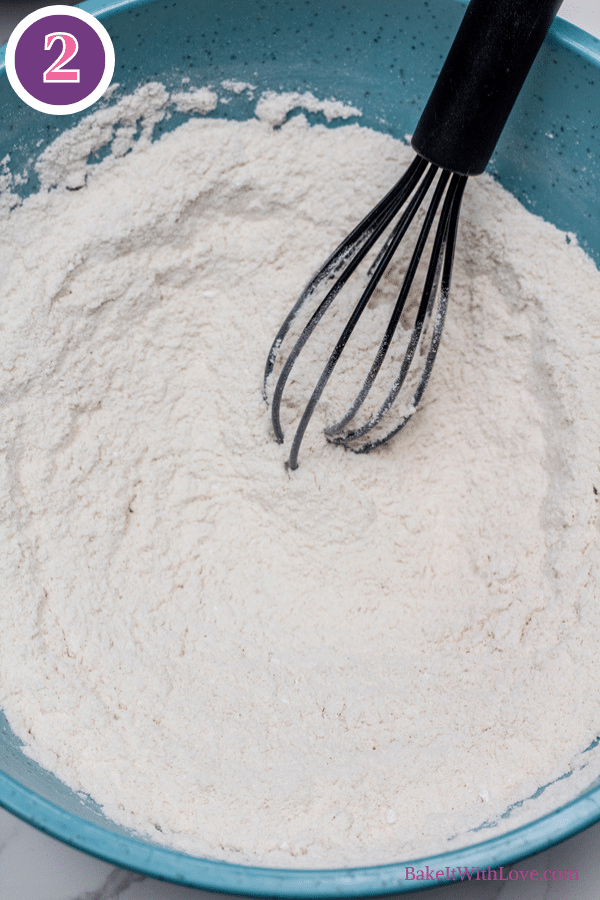
Step 3: Combine dry ingredients. In a large mixing bowl, combine the dry ingredients: 2 cups (250 grams) of spooned and leveled all-purpose flour, ½ cup (100 grams) of granulated sugar, 1 tablepoon of baking powder, and ½ teaspoon salt (photo 1). Whisk these together and set aside (photo 2).
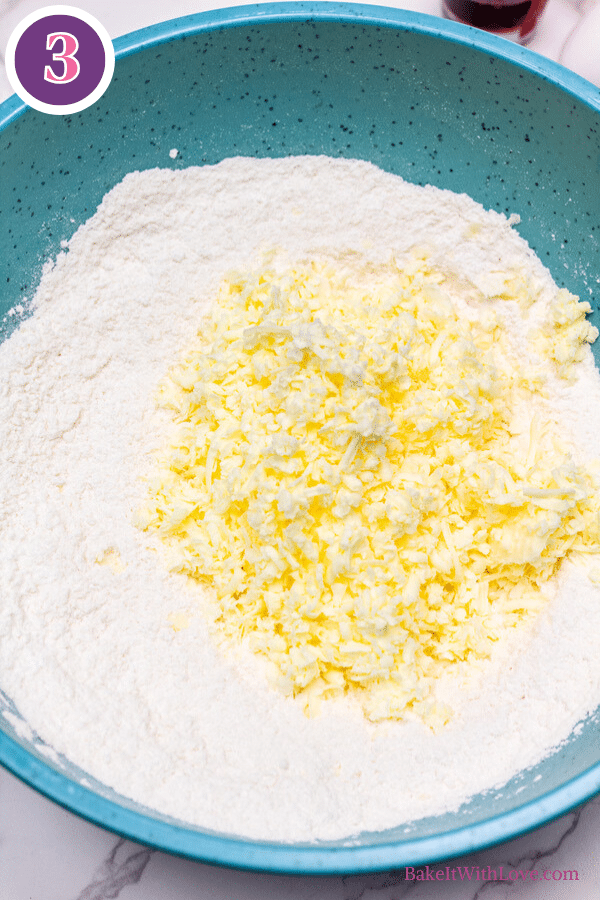
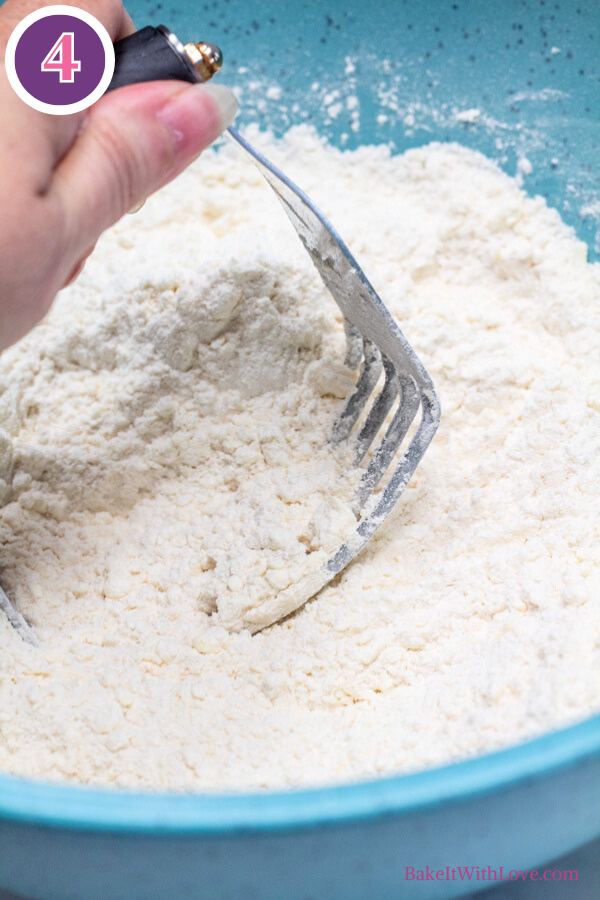
Step 4: Add the butter. Add the grated butter to the dry ingredients (photo 3) and work until just coated with the dry ingredient mixture (photo 4). Form a well in the center. *Working the butter into the flour is SO EASY when it's grated.
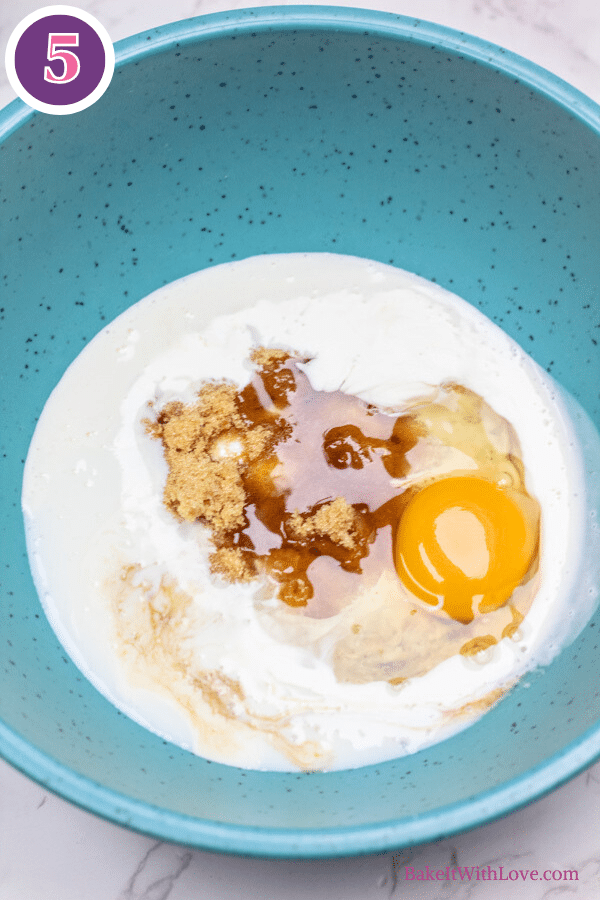


Step 5: Combine wet ingredients. Add ½ cup (118.29 milliliters) heavy cream, buttermilk, or half & half, 2 teaspoons of vanilla extract, and the optional egg (photo 5). Whisk until smooth and well combined (photo 6). *You can reserve a couple of tablespoons of this egg mixture to brush onto the scones.
Step 6: Mix the dough. Add the wet ingredients to the dry ingredients (photo 7) and mix until just combined (or wait until the stir-ins have been added, see below).
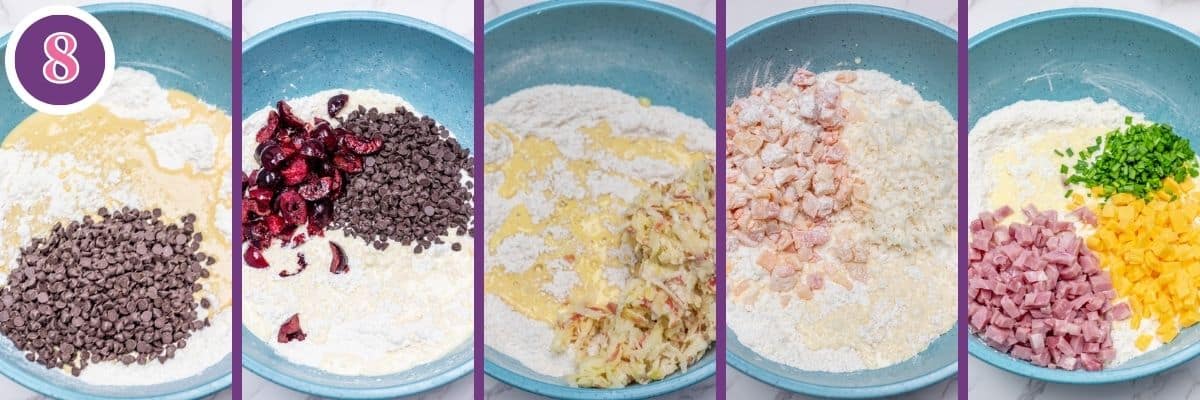
Step 7: Add any stir-ins. Mix in any desired stir-in ingredients with the wet ingredients (photo 8).

Step 8: Mix in gently. Fold into the scone dough (photo 9). Make adjustments to the flour or liquid as needed to offset the optional ingredients.
Shape, Cut & Cool
Step 9: Shape the dough. Turn the dough out onto a lightly floured working surface or pastry mat, flour your hands, and pull the dough together. It should be slightly sticky and not too dry.
Work the dough as little as possible to shape into a round that is 1-1½ inches in height and approximately 8 inches around for the standard wedge-shaped scones (photo 10).
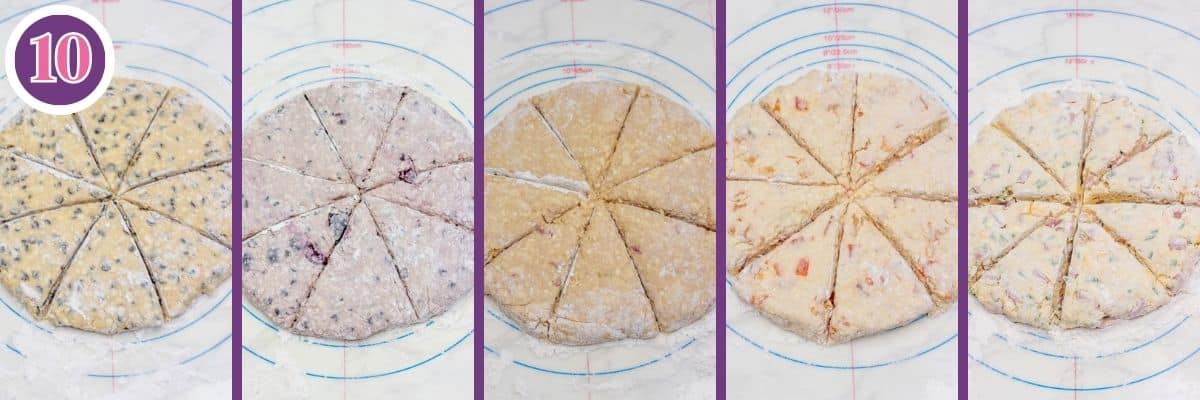
Step 10: Cut and Chill or Chill and Cut. You can cut the scones into 8 pieces like pizza slices and pop them into the oven as-is, but I suggest chilling the dough for 15 minutes (in the freezer) or 15-30 minutes (in the refrigerator), either as the round (before cutting) or as cut scones (wedges, rounds,or mini scones), before baking.
To make round scones, shape the dough into a rectangle and use a biscuit cutter to cut out the rounds (do not twist the biscuit cutter as this crimps the edges and prevents the scone from being flaky).
To make mini scones, you can shape the scone dough into two smaller rounds and cut them into 6-8 wedges. Alternatively, you can shape a rectangle like my jalapeno cheddar scones for 12 perfect petite scones. Smaller scones will bake faster, check on them after 15 minutes of baking.
Place 10-12 drop scones 3 inches apart on a parchment paper-lined baking sheet.
*Brush scones with cream, egg wash, or melted butter and top with coarse sugar before or after chilling.
Bake, Cool & Serve
Step 11: Preheat oven. While the scones chill in your fridge or freezer, preheat the oven to 400°F (205°C/Gas Mark 6).
Step 12: Bake until golden. Once your oven is preheated and the dough is chilled, bake your scones on a parchment paper-lined baking sheet for 18-22 minutes - large scones may take closer to 24-25 minutes to bake fully. *I like the way my scones brown on the bottom with parchment paper, versus baking directly on the baking sheet or on a silicone mat.
Step 13: Cool before serving. Leave the scones on your baking sheet after removing from the oven for 5 minutes, then transfer them to a wire cooling rack to cool completely before storing or serve while warm.
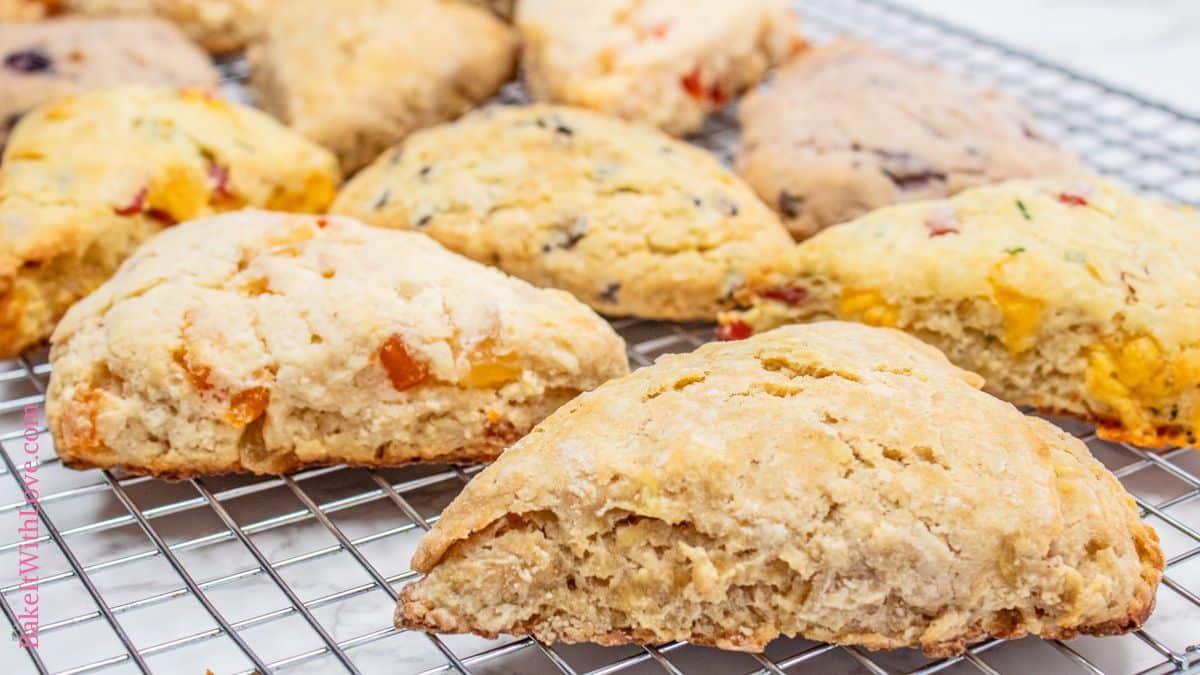
>>>See All Of My Tasty Recipes Here!<<<
🚫 How To Make Gluten-Free Scones
I feel that with so many great products available these days, you can find something that will easily work at most grocery stores. However, my favorite brands to work with are Bob's Red Mill and King Arthur.
Both brands offer a simple 1 to 1 flour replacement so you can bake without calculating your substitutions.
💭 Angela's Pro Tips & Recipe Notes
- Keep your butter (and everything else) cold. I chill my bowls, freeze my butter and flour, and make it a point to return the scone dough to the fridge or freezer if I feel my butter is getting too warm while working.
- Peeling fruit is optional. If I'm grating apples or have really ripe pears, I usually skip the step of peeling my fruit. However, I do prefer (and recommend) peeling pears, peaches, nectarines, or chopped apples.
- Don't handle the scone dough more than is needed. Gently fold in your stir-in ingredients and shape the dough quickly to avoid overworking the dough and melting the cold butter.
- Arrange the cut scones or drop scones with 3 inches of spacing between the scones to allow for spreading.
- If your scones are spreading during baking, pop them out of the oven and use a spatula to press the edges back into your desired wedge or round shapes.
🔐 Secrets For Tall, Flaky Scone Perfection
Baking perfectly flaky scones is a rewarding experience that tastes amazing, too. One of the trademark components of a great scone is a light, flaky, and airy scone that is tender inside with crisp edges.
To achieve tall, flaky scones, remember my key tips:
- Try folding the scones for the lamination process. The butter in folded layers creates steam as it melts while baking, adding lift to your layered scones. It's easy to do, too. Bring the dough together, flatten it, fold, and repeat up to 4-5 times to complete the laminating process.
- Chill the scone dough. Chilling the scones reduces the likelihood of them spreading while baking. You can chill the dough once shaped into a round before baking, or after cutting scones into wedges or rounds using a biscuit cutter.
- Bake in a preheated oven. Don't pop your scones into the oven before it's done preheating. You need the correct temperature to fully activate the baking powder.
- Use fresh leavening agents if your scones are turning out flat and dense. This would be the last troubleshooting item I would look at if you've followed all of the instructions, tips, and extra tidbits here on this page. If you're using old baking powder, test it, then try a new container in a fresh batch of scones.
🥣 Add-ins & Scone Flavors
- Plain - Make this base recipe as-is without any stir-ins, additions, or toppings of any kind for the perfect tender scone that pairs with anything.
- Chocolate Chip (pictured this page) - Add 1-1¼ cups milk chocolate or semi-sweet mini chocolate chips. Split sugar and use ¼ cup granulated sugar + ¼ cup light brown sugar if desired, just be sure to dissolve the brown sugar in your liquids. *This yields a very chocolate chip cookie flavor in my opinion.
- Cherry Chocolate Chip (pictured this page) - Add ¾ cup semi-sweet chocolate chips or chocolate chunks and ¾ cup chopped fresh or frozen cherries (maraschino cherries work too). Drizzle with dark chocolate ganache.
- Cinnamon Apple (pictured this page) - Add 1½ teaspoons ground cinnamon plus 1 heaping cup of peeled and finely chopped or grated apple. Don't use too much apple, or else the scones won't hold their shape. *I add up to ½ cup of flour to coat my grated or chopped apples.
- Tropical Fruit (pictured this page) - Add 8 ounces of dried tropical fruit blend plus ½ cup shredded sweetened coconut. Don't use too much of the coconut or the scones won't hold their shape.
- Ham Cheddar and Chives (pictured this page) - Reduce sugar to 2 tablespoons and omit vanilla extract, add ½ teaspoon garlic powder, ⅛ teaspoon salt, 2 tablespoons fresh chopped chives, 1 cup shredded cheddar cheese, and ½ cup finely diced ham.
- Blueberry, Lemon Blueberry, or Lemon Poppyseed - Add 1 generous cup of blueberries to the base recipe. Add 2 generous tablespoons (typically 2 large or 3 medium lemons, zested) lemon zest for lemon blueberry, and 2 tablespoons poppy seeds for lemon poppyseed (with or without blueberries). Try my tasty Blueberry White Chocolate Chip Scones and Blueberry Cream Cheese Scones.
- Strawberry - Add 1 cup chopped fresh strawberries, and use 2 tablespoons of your flour to coat the wet berries before mixing. Or try my Strawberries and Cream Scones.
- Raspberry Chocolate Chip or White Chocolate Chip - Add 1 cup fresh raspberries (broken or cut into 2-4 pieces, then frozen, or use gently crushed freeze-dried raspberries) + 1 cup milk chocolate, semi-sweet chocolate, or white chocolate chips.
- Cinnamon Chip - Swap sugar for light brown sugar and 1½ teaspoons ground cinnamon plus 1¼ cups cinnamon baking chips. Top with coarse sugar before baking, or vanilla icing drizzle once cooled.
- Cranberry Orange or Raspberry Orange - Use 3-4 tablespoons of orange zest (typically 2 medium or large oranges), swap orange juice for lemon juice (if using), then add 1 cup cranberries or 1 cup fresh raspberries (broken or cut into 2-4 pieces then frozen, or use gently crushed freeze-dried raspberries).
- Maple Bacon (with Maple Glaze) - I recommend my candied bacon for this scone recipe. Use ¼ cup heavy cream + ¼ cup maple syrup, reduce vanilla extract to 1 teaspoon, and chop 2 crisped slices of bacon. Use ¼ cup powdered sugar and drizzle in maple syrup until your consistency is reached, adjust sweetness with a pinch of salt. Top with candied or crisped bacon crumbles if desired.
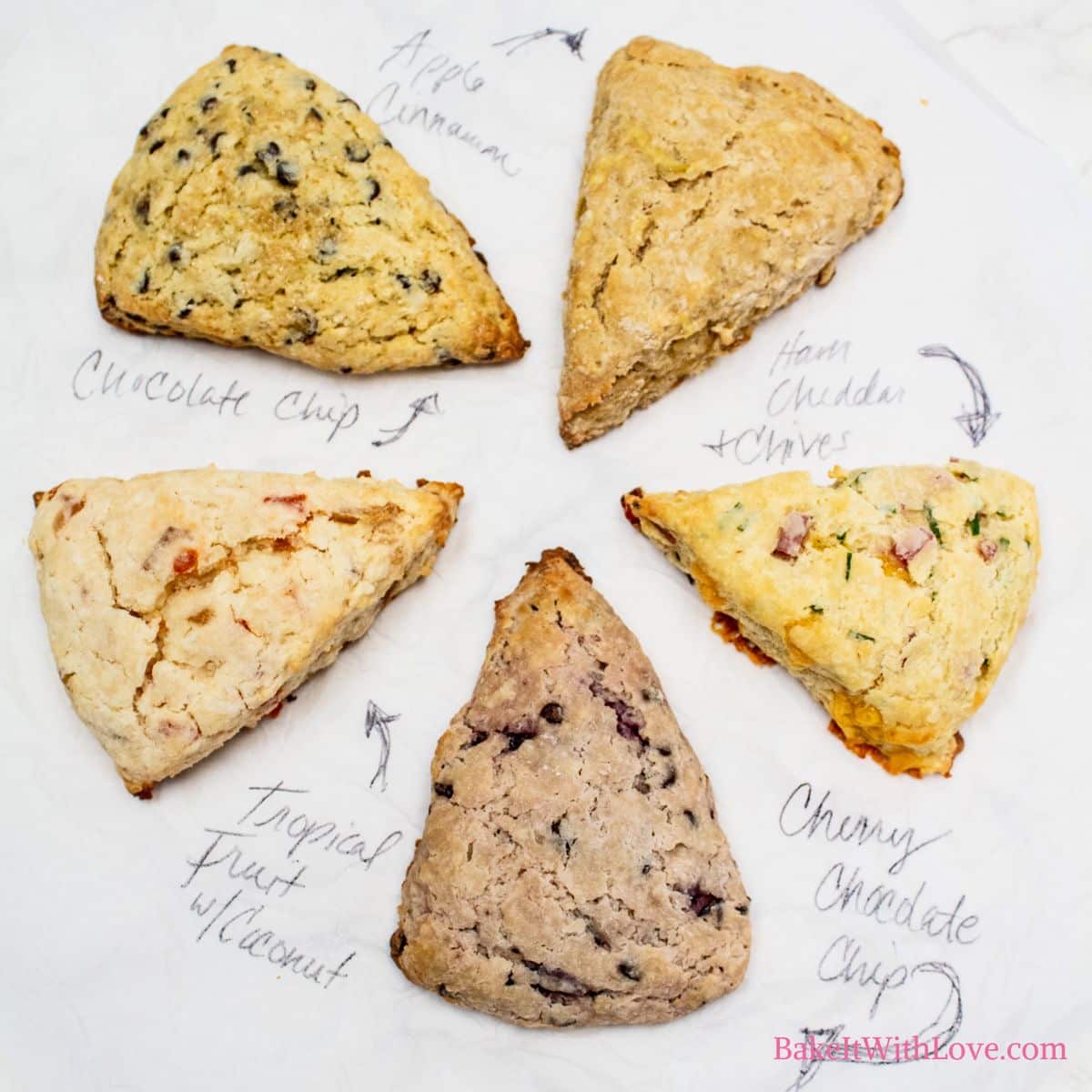
More sweet scones flavor inspiration includes combinations like mixed berry, pumpkin scones (with homemade pumpkin pie spice, and with or without pumpkin puree), banana scones, triple chocolate, strawberry or raspberry lemonade, or cherry limeade.
There are LOADS of great flavor combos shared here, but for more savory ideas like my jalapeno cheddar scones, try adding shallots (sauteed or not), green onions, sun dried tomatoes, goat cheese, feta, gruyere cheese, chorizo, browned beef, pork, or sausage, carrots, or add fresh herbs like thyme or rosemary (especially in a ricotta or cottage cheese based scone).
Be sure to keep your stir-ins to 1½ cups maximum for each 1x batch of this base recipe. Using more mix-in ingredients will result in scones that are prone to falling apart when handling them.
>>>See All Of My Tasty Recipes Here!<<<
💧 Making Adjustments For Moisture
Here are my general rules for adding ingredients that will add moisture or too much liquid to the master scones recipe:
- Add-ins like nuts, chocolate chips, dried fruit, or shredded coconut are generally easy enough to mix into your dough without any adjustments.
- Low-moisture fruit, berries, meat, or olives, that you can fold without breaking into the dough too much, typically only require ¼ cup (30 grams) additional flour to offset the moisture content.
- Ingredients with more liquid content (and this may be that your strawberries are super juicy, or your apple variety, etc.), such as raspberries or frozen cherries, can need anywhere from ½-¾ cups (60-90 grams) additional flour to give them the structure needed for shaping, cutting, and baking.
Add just a drizzle more liquid to a dry mixture, or add flour one tablespoon at a time to a wet dough for making the last dough adjustments to this recipe.

🧁 Optional Scone Toppings
My favorite easy toppings for delicious scones every time include: vanilla icing, chocolate ganache drizzle or icing, salted caramel, lemon icing, maple icing, brown butter icing, lemon curd, orange icing, raspberry icing, or a dusting of confectioners' sugar.
I'm looking forward to trying my brown sugar streusel topping on my next apple or banana batch.
🥄 Make Ahead Options
- Follow the instructions for making your scones through shaping the round, then cover with plastic wrap and store overnight in the fridge. Cut and place onto your baking sheet in the morning and bake as instructed.
- Alternatively, you can par-bake scones about ½-¾ way done. Place in a single layer on a baking sheet to flash freeze, then store them in an airtight freezer container for up to 2 months. Bake from frozen when ready to serve.
- Freeze the scone dough to bake later. Flash freeze the cut scones as directed above, then place them into an airtight freezer bag or container. I prefer to wrap the frozen scones with cling film first to prevent freezer burn.
Freeze for up to 2 months before baking for best results. Bake from frozen, adding a few minutes to the baking time. Or, thaw overnight and bake as usual.
🥡 Storing
Store cooled scones in an airtight container in a single layer if topped with an icing, or with a sheet of parchment paper between layers if plain. Alternatively, single scones can be wrapped tightly in plastic cling film.
At room temperature, the scones will store for up to 2 days. I suggest keeping them away from heat sources, and out of the sunlight - a cool, dark place like a cabinet or pantry.
Refrigerated
If refrigerated, scones should last for up to a week. Note that stir-ins with a high moisture content can shorten the amount of time that scones can be stored well (and maintain their texture).
Scones with perishable ingredients (meat, custard, cottage cheese, ricotta, etc.) should be refrigerated rather than stored at room temp.
Freezing Scones
Freeze scones in a single layer on a baking sheet, then wrap with plastic wrap and store in a freezer bag or an airtight container for up to 3 months. Thaw at room temperature or in the refrigerator overnight if your scones have perishable ingredients.
Reheating
I think that scones are best served slightly warm, so I warm them on half power in the microwave for 20-30 seconds with a glass of water. Heat in a toaster oven on the warm setting or at 300°F (150°C), or in the oven at 350°F (175°C/Gas Mark 4) for 5 minutes - cover with aluminum foil for best results with either of these reheating methods.
For frozen scones, reheat on high heat at 450°F (230°C/Gas Mark 8) for about 5 minutes to restore their crisp edges and all.
Do you love a recipe you tried? Please leave a 5-star 🌟rating in the recipe card below and/or a review in the comments section further down the page.
Stay in touch with me through social media @ Pinterest, Facebook, Instagram, or Twitter! Subscribe to the newsletter today (no spam, I promise)! Don't forget to tag me when you try one of my recipes!
📖 Recipe Card
Master Scone Recipe: How To Make The Best Homemade Scones
Ingredients
- ½ cup butter (frozen or chilled)
- 2 cups all-purpose flour (spooned & leveled - more for flouring your working surface)
- ½ cup sugar (reduce by 1-2 tablespoons for savory scones, see notes for using brown sugar)
- 1 tablespoon baking powder
- ½ teaspoon salt
- ½ cup heavy cream (or buttermilk, see notes - to brush on scones)
- 2 teaspoon vanilla extract (omit for savory scones)
- 1 large egg (optional)
- 1-1½ cups flavor stir-ins (optional - chocolate chips, berries, fresh or dried fruit, nuts, and seeds, etc)
- coarse sugar (optional - for topping the scones)
(Note: 2x or 3x only changes the ingredient list)
Instructions
Prep Ingredients
- Grate the frozen ½ cup butter and return it to the freezer while you prepare your other ingredients.
Mix Scone Dough
- Mix dry ingredients in a large mixing bowl. Add 2 cups all-purpose flour, ½ cup sugar, 1 tablespoon baking powder, and ½ teaspoon salt. Whisk together.
- Add grated butter to the dry ingredients and work into the flour using a pastry cutter, a pair of knives, a fork, or your hands to coat the butter with flour until crumbled. Make a well in the center of the flour.
- Mix the wet ingredients in a medium mixing bowl. Add ½ cup heavy cream, 2 teaspoon vanilla extract, and the optional 1 large egg. Whisk until combined.
- Pour the wet ingredients into the well in the dry ingredients along with 1-1½ cups flavor stir-ins and fold to combine to make a sticky dough. *Make any adjustments to the dough as needed with your additional ingredients, see post.
Shape, Chill & Bake
- Turn the dough out onto a lightly floured working surface and, using floured hands, shape into an 8 inch disc that is 1 inch to 1½ inches tall. Cut into 8 wedges and chill for at least 15 minutes in the fridge or freezer before baking.
- Preheat oven to 400°F (205°C/Gas Mark 6) while the scones chill.
- Brush the scones with cream, an egg wash, or melted butter over the scones then sprinkle with optional coarse sugar before baking for 18-22 minutes (large scones may bake for closer to 24 minutes).
- Leave the scones on the baking sheet for 5 minutes when done, then serve warm or transfer to a cooling rack to cool completely.
Notes
- Keep your ingredients and equipment cold before and during the mixing process.
- Don't handle the dough more than needed (to keep the warmth from your hands melting the butter in the dough).
- Arrange scones on a parchment paper-lined baking sheet with 3 inches of spacing.
- If your scones start spreading while baking, use a spatula to push the edges back into place.
- Make ahead: Shape the dough and chill the night before covered with cling film. Cut the next day and bake as instructed.
- To store: Wrap scones in plastic wrap and place into an airtight container. Store for 2 days at room temperature if there are no perishable stir-ins. Store in the refrigerator for up to a week.
- To freeze: Flash freeze in a single layer for one hour then wrap and transfer to a freezer storage bag or airtight container. Store for up to 3 months.


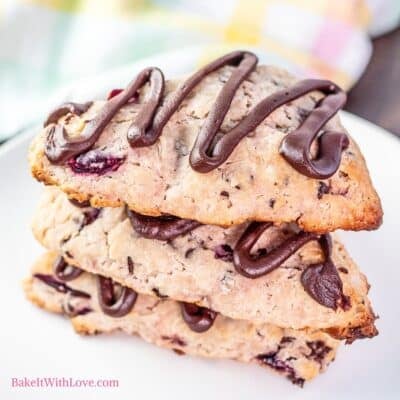
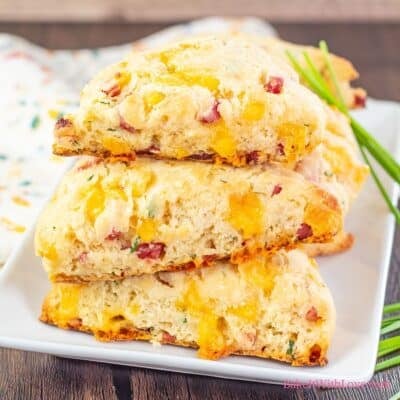
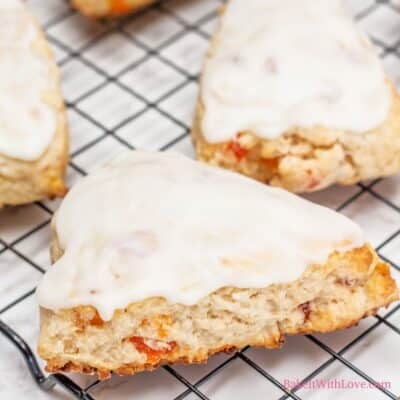
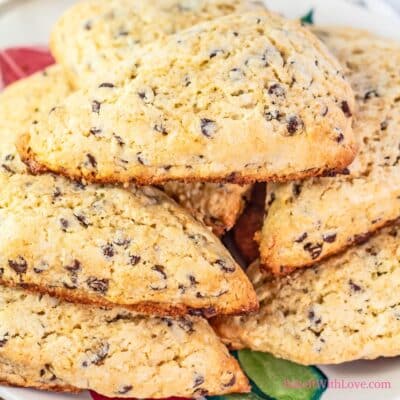

Mia says
Yum!
Angela Latimer says
I agree! I love scones 💖
Angela Latimer says
This complete master scone recipe is just what you need to create amazing scones you and your family will love! ~ Angela